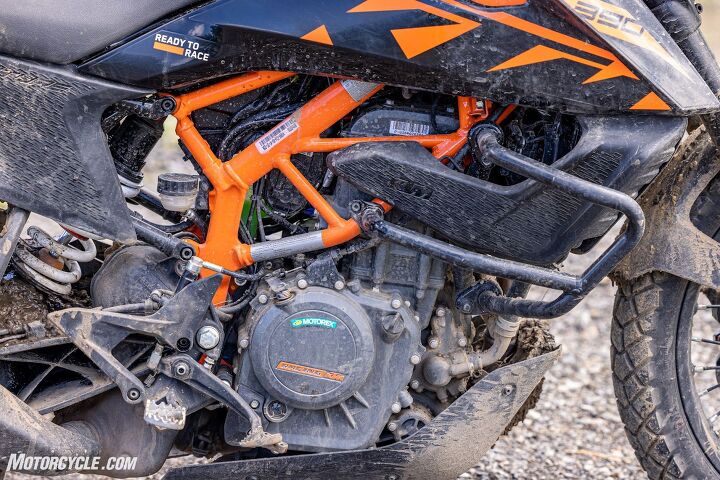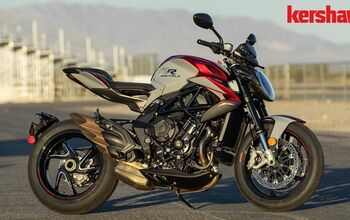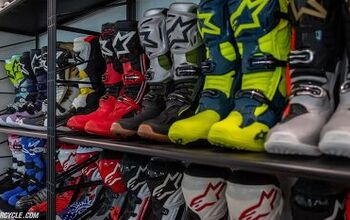KTM 390 Adventure: 5 Things You Need To Know

Lightweight adventure bike with class-leading features
Some readers have asked us what we were thinking when we put the little KTM 390 Adventure in our South Dakota shoout with the Aprilia Tuareg 660, the Ducati DesertX, and the BMW 1250 GS. We were saying that Adventure bikes don’t need to be big to have fun on all terrains. Significantly lighter than the other bikes in the shootout, the 390 has a lot of things going for it. The 390 Adventure has been a good seller for KTM, and we’ve really enjoyed it every time we have one in our hands. So, what makes the KTM 390 Adventure so special?
Motorcycle.com's 2023 South Dakota Adventure Tour
Motorcycle.com would like to thank Travel South Dakota for sponsoring this video.
1. Solid Engine
The 390 Adventure gets its power from a 373 cc Single, and the 89 mm x 60 mm bore and stroke breathe through four DOHC-actuated valves, delivering around 42 hp and 27 lb-ft of torque, like every other KTM 390 we’ve tested. While that’s not a lot of power, it was more than enough to almost hang with the big boys on our South Dakota trek. On the highway, it had a clear disadvantage under acceleration, but a judicious application of throttle and shift lever allowed the little KTM to catch up – just like with its siblings the 390 Duke and the RC390, which share the same power plant. When it came to rocky or tight, technical terrain, the Little Single that Could just chugged over everything we tossed at it. With an easy-to-manage clutch, the 390 was a popular choice in the tough stuff. The only fly in the engine ointment was a difficult quickshifter for upshifts in lower gears. This was a huge surprise since KTMs generally have very slick electronics in this regard. Finally, in off-road riding, where it really matters, the 390 engine sipped the gas from its 3.8 gallon tank, allowing for extended range.
2. Outfitted For Adventure Travel
The 390 Adventure comes with key components for life on the road. First and most importantly, engine guards are standard equipment. Anyone who is honest with themselves about wanting to ride this bike off-road knows that at some point, the bike will end up on its side. The engine guards are a key component for keeping an embarrassing moment from being a trip ending one. When it comes to getting to, from, and through those remote locations, the standard Continental TKC-70 tires are more than up for the job, delivering great performance on pavement and competent performance in the dirt, which is the very definition of a good all-around adventure tire.
Still, there is room for improvement. The plastic hand guards look the part, but we’ve managed to crack one every time we’ve tested the 390 Adventure. We wish that a stronger supporting structure were used. Similarly, while a portion of the included bash plate is metal, we’d prefer an all-metal one. Fortunately, there is one available from KTM’s PowerParts catalog. Even with these quibbles, the little Adventure arrives ready for road and dirt. All you need to do is strap on some bags.
3. Awkward Standing Position
Newbies and pros alike know that when the going gets technical in off-road settings, often the best position to be in is standing on your pegs. Handlebar placement is key for comfort and ease of operation. Unfortunately, the 390 Adventure’s handlebar is simply too low for most riders. Our crew ranged from 5’8” to 6’4”, and every single rider complained about the KTM’s handlebar height. The good news is that the fix is quite simple. Buying an aftermarket handlebar riser will place the bar right where it should be. One nice note about the handlebar is that it is a tapered aluminum item instead of the less sturdy steel that many manufacturers use.
4. More Expensive Than Others In Its Class
The KTM 390 Adventure has a base retail price of $7,399. That’s $1,950 more than the Royal Enfield Himalayan and $1,500 more than the Kawasaki Versys-X. That’s a big chunk of change. Still, you do get a lot for all those greenbacks. First, the 390 has lean sensitive traction control and cornering ABS which are all controlled by a three-axis IMU. While maybe not as necessary as on larger bikes, both of these are good to have when the going gets slippery. Also included is the WP Apex suspension, which comes with a compression- and rebound-adjustable fork and a rebound- and preload-adjustable shock. Neither of these are available on other bikes in the class.
And then there is the 5-in. TFT screen. KTM has been on the forefront of this type of display by including it on all of its street-going machinery. This gives you access to the easy-to-use menu system. Additionally, if you’re going to be revving out the engine to keep up with the bigger kids, having the tach change colors and flash as the engine approaches redline is a nice touch. Also, if you want to spend a little bit more, you can update to include Bluetooth that allows for the use of KTMconnect and its ability to show call information and, more importantly, turn-by-turn directions.
5. Punches Above Its Weight
If you still think the 390 Adventure is too expensive, consider this: The mere fact that we included it in our South Dakota shootout says how highly we regard the bike. Comparing it to a 660, a 937, and a 1,250 may sound unfair, but the engine won our hearts and held its own. It even survived a bath in the same puddle that took out the BMW GS. Oh, and weighing almost 200 lb. less made the KTM much easier to pick up. And that’s all before we consider the minimum of a $5,300 price delta with these bikes.
With the 390 Adventure, riders get a willing engine that is just as happy singing at its rev limit as it is tractoring over baby head rocks. It has better suspension and more advanced electronics than the other bikes in its class, and although it may cost more, 390 Adventure riders get features commensurate with the cost. Adventure bikes don’t have to be big to get you where you want to go and have a ton of fun doing it.
Become a Motorcycle.com insider. Get the latest motorcycle news first by subscribing to our newsletter here.

Like most of the best happenings in his life, Evans stumbled into his motojournalism career. While on his way to a planned life in academia, he applied for a job at a motorcycle magazine, thinking he’d get the opportunity to write some freelance articles. Instead, he was offered a full-time job in which he discovered he could actually get paid to ride other people’s motorcycles – and he’s never looked back. Over the 25 years he’s been in the motorcycle industry, Evans has written two books, 101 Sportbike Performance Projects and How to Modify Your Metric Cruiser, and has ridden just about every production motorcycle manufactured. Evans has a deep love of motorcycles and believes they are a force for good in the world.
More by Evans Brasfield

































Comments
Join the conversation
A lot of motorcycles are built in Democracies, Japan, Austria, Spain, Italy, etc. You don't have to buy just a Harley to support Democracy. You sure don't have to support the Communist in China. Every dime you give China they use it against us.
I burst out laughing when I read the words, " a willing engine that is just as happy singing at its rev limit as it is tractoring over baby head rocks." I'm riding my 6th DRZ-400 and I sell my bikes when they get between 35 and 40 thousand miles. I've been looking for years for something with a six-speed transmission, light weight, fuel injection, 2,000 plus mile oil change intervals and more highway capable than my DRZ. When the 390 Adventure came out, I thought I had found it and I immediately bought one. I sold it less than 2 months later with a little over 2,000 miles on it. The ability of a 390 Adventure to tractor over baby head rocks is similar to the capability of a 500cc two stroke GP engine in a bulldozer being able to move mounds of dirt. First gear is too high, and the engine is tuned for horsepower, not torque. It's a much better road bike than my DRZ, but its engine is not ready for steep, tight switchbacks in rough terrain, similar to what one would encounter on the Alpine Loop in Colorado.